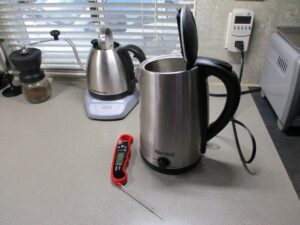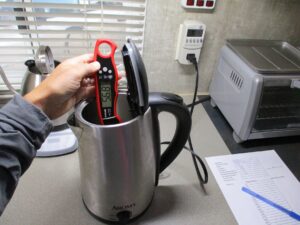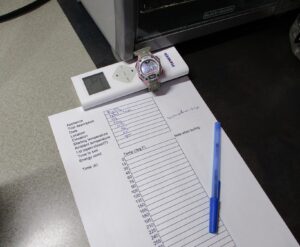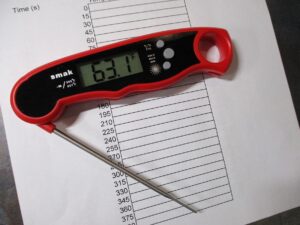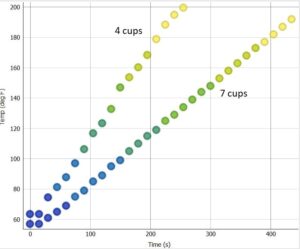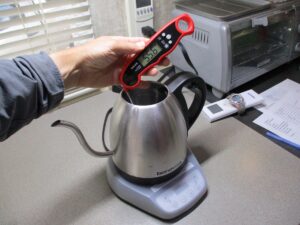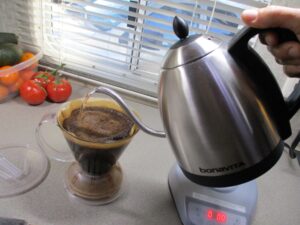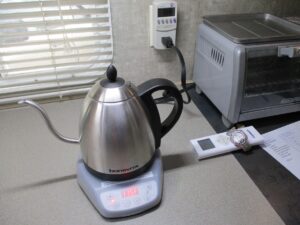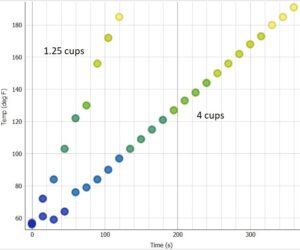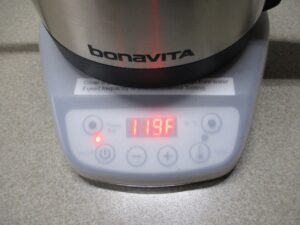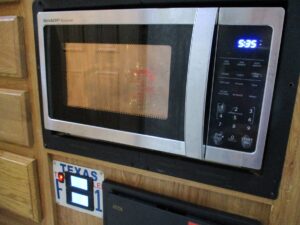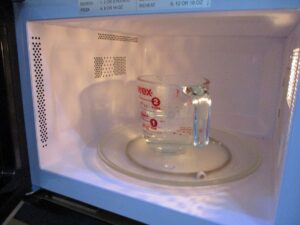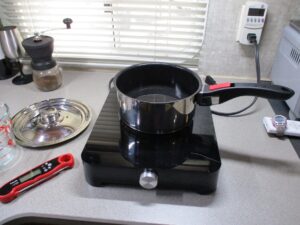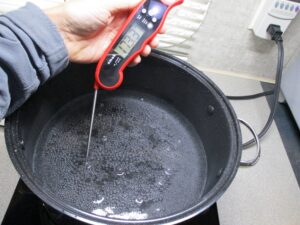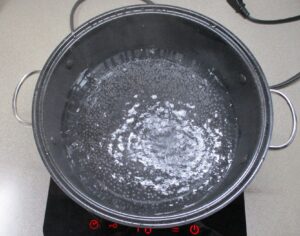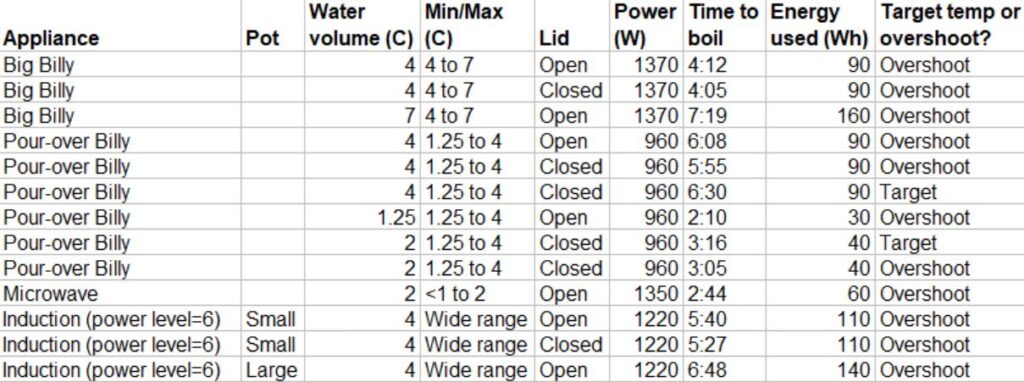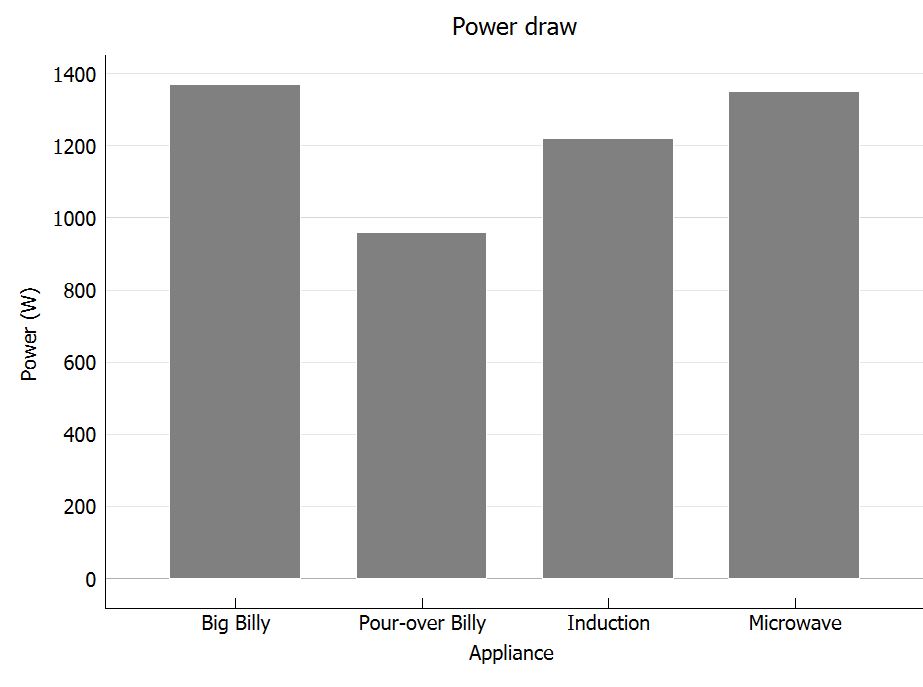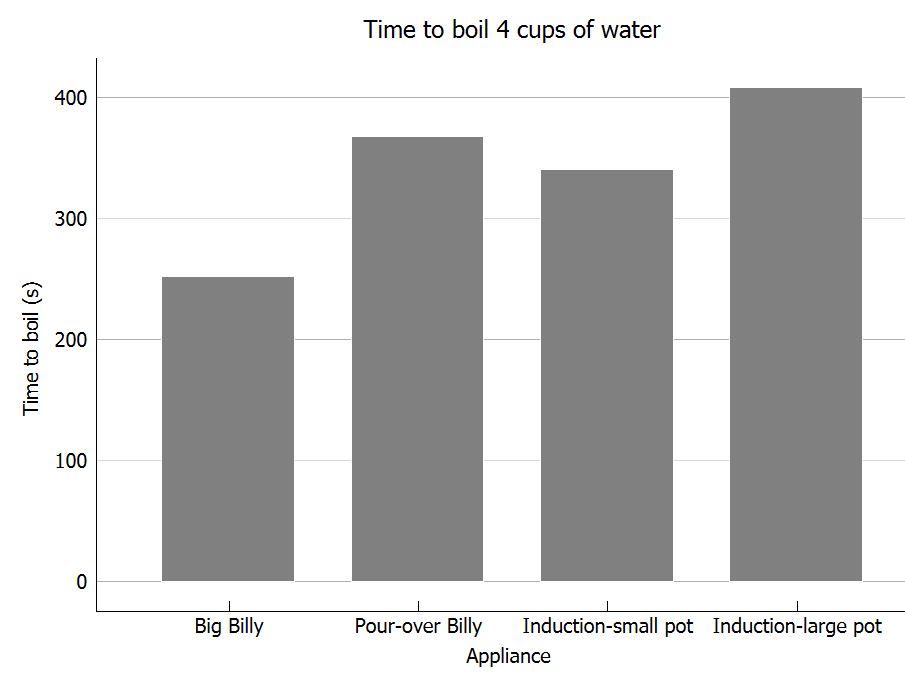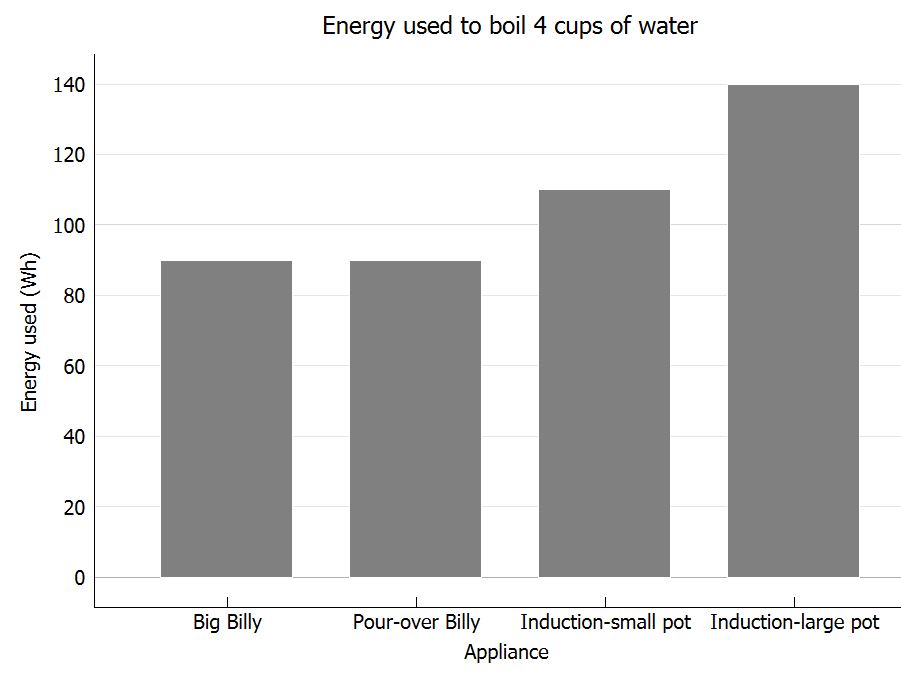It has been a while since I experimented and collected data, so a simple comparison of different electric cooking methods sounded like fun. A while back I received a specific question about how our electric kettle compared to heating water in the microwave, so this should answer that too.
These are the various ways we can boil water in our trailer:
1. Electric kettles – the larger one we started with and the smaller pour-over version we currently use
2. Microwave
3. Induction cooktop and compatible pot (2 pot sizes available)
We also have (and love) an Instant Pot, and although I considered included it in this test, it’s likely not something anyone has used for the express purpose of boiling water. I couldn’t imagine it, but let me know if my imagination is too limited.
I bought a little digital thermometer (more gear!), created a basic data collection sheet, and put on my engineer hat for a few hours.
Some parameters that were basically the same for all the tests I ran:
Location = Flagstaff, AZ
Elevation = 6970 feet
Water starting temperature = 56 to 61 degrees F
Ambient temperature = 62 to 65 degrees F
In addition to type of appliance and pot size, variables included:
Volume of water
Open vs. closed lid
I collected data on:
How much instantaneous power each appliance used
Time to boiling
Energy required to boil water
Any notes on pluses/minuses with each method
I defined boiling roughly as seeing large bubbles breaking the surface, hearing the sound of boiling, and the temperature hitting the mid-190’s. At this elevation, the boiling point of water is 199 degrees, but the actual process appeared to start several degrees earlier. It didn’t make much difference either way; the “time to boil” and amount of energy needed would be about the same either way.
I’ll go through each method of water heating and then summarize the results at the end. Feel free to skip to that, or stay with me for all the fun details.
Let’s start with the older kettle, the “Big Billy”:
Big Billy works well with larger volumes of water:
Minimum water level = 4 cups
Maximum = 7 cups
It has a temperature setpoint knob so you can adjust how hot the water gets before it automatically shuts off. I used the Max setpoint for this test and turned it off manually.
I collected power and energy data using a Kill-a-Watt, a handy device for any plug-in appliance testing. This worked for everything except the microwave (which has a hidden plug, and I didn’t know until later that I could have accessed it with a little work).
Using the Big Billy, I tried several versions:
4 cups of water, lid open
4 cups of water, lid closed
7 cups of water, lid open
When the lid was open, I gathered temperature data every 15 seconds. I eventually learned to keep a small towel handy to wipe steam off the thermometer display. The towel was also good to have around when pouring water back and forth a lot.
Gathering data:
A close-up view of the thermometer – it’s a handy little thing, easy to use, and most happily has a magnet so it lives (as many magnetic items now do) on the fridge door.
The large kettle pulls the most power, at 1370 watts. This goes along with the “good for heating a larger volume” idea.
I didn’t see much difference between an open and closed lid. 90 watt-hours (Wh) was needed either way. Time to boil 4 cups of water was almost the same, 4:12 with an open lid and 4:05 with a closed one.
The main difference was when the water volume changed:
4 cups of water = 4:12 minutes and 90 Wh
7 cups of water = 7:19 minutes and 160 Wh
Temperature over time for the two volumes:
Next up! Our new electric kettle – the pour-over Billy. For some reason which I can’t remember, I went online kettle shopping, and I was excited to find a version that has some improvements for us:
a) The pour-over spout is probably #1. Our main coffee-making method is grinding decaf beans and using a Clever device with cone filter. The Big Billy worked OK, but it’s much nicer having precise control of the water flow.
We started this whole “find our coffee making process” (over a year ago) with a pour-over kettle that didn’t have self-power, i.e. we had to use the induction cooktop and then leave it out all the time. I much prefer to store the cooktop in a drawer except for supper cooking, as it takes up quite a bit of space. Either electric kettle fits on the counter a whole lot better for (almost) instant hot water.
b) We like the lower volume of our new kettle, especially a minimum level of 1.25 cups instead of 4 cups. Less wasted water and electricity for the 2-3 cups we normally boil.
Minimum water level = 1.25 cups
Maximum = 4 cups
Making coffee:
c) It turns out that I also appreciate the precise temperature control of the new device. It has a digital temperature setpoint, plus it slows down the heating (via cycling off and on) as it nears the target. This is great for aspiring coffee snobs who figure that it’s probably helpful to attain a close-to-exact temperature for brewing instead of (gasp!) possibly a few degrees too high or low.
I found a list of temperature ranges for brewing beverages:
Coffee brewing = 195-205 deg F (just at boiling)
Black and herbal tea = 205-210 deg F (full boiling)
Oolong = 175-185 deg F (just off boil)
Green = 165-175 deg F
White = 150-155 deg F
Cocoa = 175-185 deg F
Of course, we are much less precise about the rest of the brewing process, and we’ve never been particularly picky about our cuppa Joe. It’s just fun to imagine that we know a tiny bit more about it now than we used to.
Moving on!
I ran the following tests with the new pour-over kettle:
4 cups of water, lid open, high setpoint to overshoot the boiling point
4 cups of water, lid closed, with overshoot
4 cups of water, lid closed, targeting the boiling temperature
1.25 cups of water, lid open, with overshoot
2 cups of water, lid closed, both with overshoot and to the target temperature
The tests with 2 cups of water are for comparison to the microwave data.
This kettle pulls 960 watts of power, the low end of the appliances I tested.
Again not much difference between an open and closed lid. 90 Wh was needed to boil 4 cups of water, the same amount of energy as the large kettle. Time to boil was 6:08 with an open lid and 5:55 with a closed one. It does take longer than the Big Billy, to be expected with the lower power draw.
The main difference was again when the water volume changed:
4 cups of water = 6:08 minutes and 90 Wh
2 cups of water = 3:05 minutes and 40 Wh
1.25 cups of water = 2:10 minutes and 30 Wh
Data from the open lid tests where I have 15-second readings:
Setting the temperature target to the boiling point, as opposed to overshooting it, produced the expected results. It took the same amount of energy to get there, it just took a few seconds longer:
4 cups of water:
Overshoot = 5:55 minutes; using a targeted temperature = 6:30 minutes
2 cups of water:
Overshoot = 3:05 minutes; using a targeted temperature = 3:16 minutes
Here’s a look at the controls; once we have the temperature set like we want, we only use the on/off button and it remembers what we like.
The third appliance is our little microwave:
I ran one test, using a glass measuring cup. The minimum volume is probably quite low, less than 1 cup, but I just went with the maximum of 2 cups of water.
Using the Kill-a-Watt would be a bit more difficult, involving removing a drawer and finding the outlet where the microwave is plugged in. Easy if John were home to point the way. For me it was simpler to take the power draw from our battery meter and multiply it by the run time.
I watched through the window until there were obvious bubbles and stopped the microwave at that moment.
The power draw is 1350 W. To boil water, it took 2:44 minutes and 60 Wh.
Compared to the pour-over kettle at the same volume, the microwave is 20 seconds faster and uses 50% more energy. Interesting, but probably won’t drive any decisions about which one to use. Whatever is more convenient, I say.
For us, the glass cup (or any other microwave-safe mug) doesn’t work very well for slowly pouring liquid into another container like the Clever coffee device. No matter how careful we try to be, there tends to be drips and spillage.
Finally, the induction cookset and a couple different pot sizes.
I ran the following tests, all with 4 cups of water and a setting of “6” on the cooktop:
Small pot, open lid
Small pot, closed lid
Large pot, open lid
This power setting is on the higher end of the range, at 1220 W.
Here’s the small pot, which fits perfectly on the induction ring:
It’s nice to have a good match between the pot and the cooktop, because you get complete coverage of the bottom of the pot (for even cooking) without wasted energy. I don’t actually know if a small pot on a large burner wastes energy, quite honestly. Either way, it doesn’t seem like a big deal in the grand scheme of things.
As with the electric kettles, an open or closed lid didn’t make a large difference:
Small pot, open lid = 5:40 minutes to boil, 110 Wh required
Same pot with a closed lid = 5:27 minutes to boil, 110 Wh
One interesting comparison is that the induction setup needs about 20% more energy to boil water compared to either of the kettles.
Obviously, the main advantage to the induction setup is the ability to cook things that aren’t water.
The large pot is a couple inches bigger (on the radius) than the induction ring. It will still boil water (and cook food) just fine, but the edges take longer to heat up and it’s best to stir your food frequently to evenly heat it.
It took longer for the water to boil in the large pot (note that I was not stirring it during the test):
Large pot, open lid = 6:48 minutes, 140 Wh
The boiling bubbles came out in the ring shape, and the water on the edges was a couple degrees cooler compared to the center.
Here’s the summary table:
Graphics with some of the same info…
Big kettle:
Pros = Easy to boil water, large volume, high power
Cons = Can’t go below 4 cups at a time, not as precise for pour-overs
Pour-over kettle:
Pros = Easy to boil water, smaller volume (less wasted water and energy), precise temperature control, and easy pour-overs
Con = Takes a little longer to boil
Microwave:
Pros = Easy to boil water, faster than the other methods
Cons = A tad less efficient, hard for pour-over coffee
Induction cooktop:
Pros = Best for cooking anything other than water, good for higher volumes, variable input power
Cons = Requires more counter space (or setup time), takes more energy, hard for pour-over coffee
The real summary is probably this one-liner: It doesn’t take much energy to boil water.
